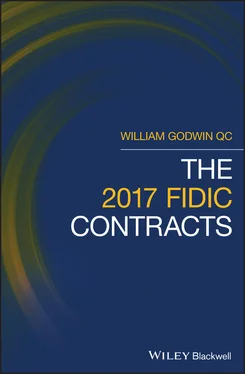In the 2017 edition of the Silver Book the Employer is obliged to appoint an Employer's Representative and so cannot administer the Contract himself. As with the 1999 edition, determinations must be fair, in accordance of the Contract and take account of all relevant circumstances (clause 3.5). In the 2017 edition there is an added requirement (also in clause 3.5) that in carrying out his determining functions the Employer's Representative shall not be deemed to act for the Employer; unlike the 2017 Yellow and Red Books, however, he is not expected to act neutrally, although whether in practice this will make much difference is not entirely clear since in all three Books in both editions determinations have to be fair, in accordance with the Contract and take account of all relevant circumstances.
A significant difference exists between the 1999 Silver Book on the one hand, and its 2017 version and both editions of the Yellow and Red Books on the other, as to the effect of a determination. In the 1999 Silver Book, each party must give effect to a determination unless the Contractor gives notice of his dissatisfaction with the determination within 14 days; he may then refer the matter to a DAB under clause 20.4. In both editions of the Yellow and Red Books, on the other hand, the parties are to give effect to the determination unless and until it is revised by a DAB/DAAB or, ultimately, arbitral tribunal. That difference could favour the Contractor in some situations where, for example, the Employer is entitled to a payment, as the Contractor can hold off paying by notifying his dissatisfaction with the determination within the 14 days. In the 2017 Silver Book, where the Employer is no longer permitted to administer the Contract himself, the position has been changed to bring it into line with the other forms, so that both parties have to give effect to a determination unless and until it is revised by a DAAB (or ultimately an arbitral tribunal).
1.3 Contractor Risk in the Silver Book: Two Examples
The following two examples may serve to illustrate how the Silver Book stands out from the other two FIDIC forms.
1.3.1 Unforeseeable Difficulties
Clause 4.12 of the Silver Book in both editions provides that, unless the Contract (or, in the 2017 edition, the Particular Conditions) states otherwise, the Contractor (a) is to be deemed to have obtained all necessary information as to risks, contingencies and other circumstances which may influence or affect the works; (b) by signing the Contract he accepts ‘total responsibility’ for having foreseen all difficulties and costs of successfully completing the works; and (c) the Contract Price is not to be adjusted to take account of any unforeseen difficulties or costs.
This comprehensive allocation of risk contrasts with clause 4.12.4 of the Yellow and Red Books in both editions, where the Contractor may, subject to complying with the relevant notice and other requirements in clauses 4.12.1 to 4.12.3, claim both additional time and money if he encounters physical conditions which were unforeseeable in the sense that they were not reasonably foreseeable by an experienced contractor at the date of tender (1999) or the Base Date (2017).
1.3.2 Errors in Employer's Requirements
The 1999 Yellow and Silver Books impose on the Contractor the obligation to design, execute and complete the works in accordance with the Contract so that when complete the works will be fit for the purposes for which they are intended ‘as defined in the Contract’ (clause 4.1). This is similar in the 2017 editions, except that the works when completed are to be fit for the purpose or purposes for which they are intended ‘as defined or described in the Employer's Requirements’ or, where no such purposes are defined or described, fit for their ‘ordinary purposes’.
Thus the fitness for purpose obligation in the 2017 editions is anchored, not in the Contract generally, but in the Employer's Requirements or, in default, in the ‘ordinary purposes’ of the relevant works. These important distinctions are examined in Section 4.1below. 3
The extent to which the Contractor has to accept responsibility for errors in the Employer's Requirements, including any design criteria and calculations, is markedly different between the two forms.
In both editions of the Silver Book the Contractor is responsible for errors in the Employer's Requirements even if the Contractor could not reasonably have been expected to detect them, with certain limited exceptions. Clause 5.1 in both editions provides that the Contractor is assumed to have scrutinised, prior to the Base Date, the Employer's Requirements (including design criteria and calculations, if any) and the Employer is not to be responsible for any error, inaccuracy or omission of any kind in the Employer's Requirements as originally included in the Contract, unless one of the exceptions set out in sub‐paragraphs (a)–(d) of clause 5.1 applies. These exceptions are examined in Section 5.1.1 below.
The Yellow Book deals with errors in the Employer's Requirements quite differently. The Contractor is entitled to claim additional time and/or cost plus profit if a hypothetical experienced and careful contractor would not have discovered the error by a certain date.
Thus clause 1.9 of the 1999 edition entitles the Contractor to claim if delay and extra cost result from an error in the Employer's Requirements which an experienced contractor exercising due care would not have discovered when scrutinising the Requirements under clause 5.1. Although more detailed and differently structured, clause 1.9 in the 2017 edition applies a substantially similar test to determine the Contractor's right to claim more time or money in respect of errors contained in the Employer's Requirements. 4
1.4 New Potential Risks for Contractor and Employer in the 2017 Books
The 2017 Books contain new potential risks for both Contractor and Employer, some of which are highlighted below. They are considered in more detail in the chapters indicated.
New fitness for purpose indemnity
In the 2017 Yellow and Silver Books clause 17.4 creates a new indemnity by the Contractor in respect of any acts, errors or omissions by him in carrying out his design obligations which result in the works, when complete, not being fit for their purpose under clause 4.1. 5 In the 2017 Red Book this applies to the extent that the Contractor has the relevant design obligations.
In the pre‐release Yellow Book this indemnity was not within the exclusion of indirect or consequential loss or the overall liability cap under clause 17.6. However, following strong objections from contractors during the friendly review, this position has been reversed in the published 2017 Books. By a new clause 1.15 (Red and Yellow Books)/1.14 (Silver) the indemnity is now within both the exclusion and the cap. 6
Exceptions to liability limitation
The new clause 1.15/1.14 in the three 2017 Books does not include within the exclusion of indirect or consequential loss intellectual and industrial property rights under clause 17.3, or delay damages under clause 8.8, and the former is excluded from the total liability cap under the second paragraph of that clause. 7 Further, whereas in the 1999 editions clause 17.6 did not limit liability in any case of fraud, deliberate default or reckless misconduct, the new clause 1.15/1.14 adds gross negligence to this list. 8
Delay damages and termination
The 1999 editions provide, by clause 8.7, for a maximum amount of delay damages. This is also the case in the 2017 editions, but the 2017 Books give the Employer a new right to terminate the Contract under clause 15.2.1(c) if the Contractor exceeds this limit. 9
Читать дальше












